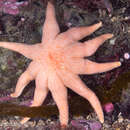en
names in breadcrumbs


“Solaster regularis, n. sp. (Pl. LXX. fig. 1; Pl. LXXII. figs. 5 and 6).
Rays eight. R = 90 to 100 mm.; r = 20 mm. R = 4.5 to 5 r. Breadth of a ray at the base 14 mm.
The disk is high and convex. The rays are long, tapering, and attenuate towards the extremity; in the present condition of the specimen all are curled over on the abactinal surface. Interbrachial arcs acute.
The abactinal surface is beset with very short, rather broad, stumpy paxillae, the crown composed of six to ten very short tapering spinelets, bi- or tridentate at the extremity, and their bases imbedded in a membranous mass, which envelops the whole basal part of the paxilla. The paxillae are widely spaced upon the disk, and numerous large papulae occupy the interspaces. Along the rays the paxillae become much smaller and more numerous. No definite order of arrangement is discernible, although a slight tendency to lineal disposition may be made out along the sides of the rays.
There is a single series of conspicuous marginal plates, on which a thin elevated keel is developed, surmounted by a flattened comb of short robust spinelets, about ten to twenty in each, resembling enlarged compressed patinas, the long axis being placed at right angles to the median line of the ray. The combs are widely spaced, and about forty-two are present between the median interradial line and the extremity. I believe these to be the infero-marginal plates; and what I take to be the representatives of the superior series are scarcely distinguishable from the paxillae of the abactinal surface generally.
The adambulacral plates are large, and their armature consists of two series of spines. (1.) A furrow series of four or five short, flat, lanceolate spinelets, each in a membranous sac, which radiate apart and form a fan on the furrow margin of the plate. (2.) An actinal series of four or five large robust spines arranged in a straight line on the actinal surface of the plate at right angles to the furrow. These spinelets are thickly covered with membrane, and normally decrease in size as they recede from the furrow. The general surface of the plate is covered with membrane.
The mouth-plates are moderately large. Their armature consists of a marginal series of about nine spinelets on each plate, the innermost three on each plate being much larger than the succeeding ones, and enveloped in wide membranous sacs, which give them a compressed lanceolate appearance; the outer spinelets are much smaller, subconical or cylindrical in appearance, and diminish in size as they recede from the mouth. On the actinal surface of each plate is a lineal series, parallel to the median suture, of five robust sacculated spines which diminish in size as they recede from the mouth, the innermost being larger than any of the other mouth-spines.
In the actinal interradial areas of the disk there are three or four series of small actinal intermediate plates, which bear small, compact, well-defined paxilliform groups of four to six short equal spinelets; only the innermost of these series extends more than a little way beyond the base of the ray.
The madreporiform body is small, and is situated rather nearer the centre of the disk than midway between that point and the margin. Its surface is slightly convex, and the striations are fine.
The ambulacral tube-feet have large, fleshy, centrally-invaginated, terminal disks. Colour in alcohol, a bleached greyish white.
Locality.—Station 308. South of Wellington Island, west coast of Patagonia. January 5, 1876. Lat. 50° 8' 30" S., long. 74° 41' 0" W. Depth 175 fathoms. Blue mud. Surface temperature 51.7° Fahr.
Remarks.—Solaster regularis is characterised by the length of the rays, and by the comparatively large and widely-spaced paxillae of the abactinal surface: characters which, taken in conjunction with the number of the rays and other minor points of detail, at once distinguish the species from its allies.”
(Sladen, 1889: 454-455)